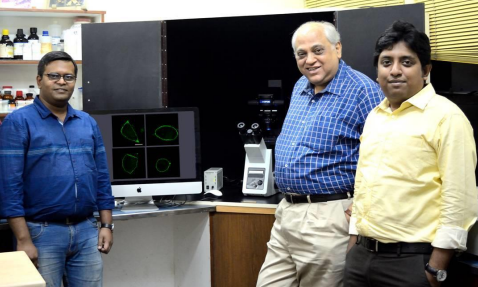CSIR - Centre for Cellular & Molecular Biology
Council of Scientific and Industrial Research
The Innovation Engine of India
Date : September 5, 2024

28.07.21: Cells communicate with each other via receptor proteins expressed on the cell membranes. Many drugs target these receptor proteins to alter cell’s functioning and physiology. However, the latest study from Prof Amitabha Chattopadhyay’s lab at CSIR-Centre for Cellular and Molecular Biology (CCMB) make a case for accounting for the lipid environment that surrounds the receptor proteins, while designing drugs acting on the latter.
The lab had earlier found that the serotonin receptors are sensitive to cholesterol surrounding them. In the new study published in Science Advances, they report a sensor region on human serotonin1A receptor that can detect cholesterol. They looked at specific regions called CRAC motifs in the receptor. These are believed to interact with cholesterol. The researchers carefully replaced specific amino acids in the CRAC motifs of the serotonin1A receptor, and identified a particular amino acid responsible for cholesterol-sensitive function of the receptor.
The researchers collaborated with Dr Jana Selent’s group from Pompeu Fabra University Hospital del Mar Medical Research Institute in Barcelona, Spain to visualize the protein-cholesterol interaction via computer-aided molecular dynamics simulations. This helped them predict how the specific amino acid on CRAC motif enables the receptor to sense changes in cholesterol levels by controlling molecular motion in certain regions of the receptor.
“These findings are important since cholesterol levels change in our cells with age and in many disease conditions. We believe our work will help in developing better drugs that keep in mind not just the receptor as the drug target, but also the lipid environment in which the receptor is present”, explained Prof Chattopadhyay.
“Our expertise in structural biology at CCMB is key towards physical understanding of cells and their functions. This not only adds to the detailed view of living cells but also have immense potential in therapeutics development”, said Dr Vinay Nandicoori, Director, CCMB.
 Advertisement no 07/10 for the post Junior Scientist.
Advertisement no 07/10 for the post Junior Scientist.
 List of shortlisted candidates for the temporary positions against CCMB Web Notif.No.0724/B- [26-08-2024]
List of shortlisted candidates for the temporary positions against CCMB Web Notif.No.0724/B- [26-08-2024]
 Result of selected candidates for the temporary positions against CCMB Web Notif.No.0724/A - [21-08-2024]
Result of selected candidates for the temporary positions against CCMB Web Notif.No.0724/A - [21-08-2024]
 Notification of Schedule for Trade Test and Downloading of Admit Cards for the posts of Gr. II (1)/Technician (1) against Advt.No:01/2021 - [19-08-2024]
Notification of Schedule for Trade Test and Downloading of Admit Cards for the posts of Gr. II (1)/Technician (1) against Advt.No:01/2021 - [19-08-2024]
 List of selected candidates for the temporary positions against CCMB Web Notif.No.0624/A - [14-08-2024]
List of selected candidates for the temporary positions against CCMB Web Notif.No.0624/A - [14-08-2024]
 List of shortlisted candidates for the temporary positions against CCMB Web Notif.No.0724/A - [02-08-2024]
List of shortlisted candidates for the temporary positions against CCMB Web Notif.No.0724/A - [02-08-2024]
 Notification No.0824/A for various temporary positions on contractual basis- [02-08-2024]
Notification No.0824/A for various temporary positions on contractual basis- [02-08-2024]
 Notification No.0724/B for various temporary positions on contractual basis - [29-07-2024]
Notification No.0724/B for various temporary positions on contractual basis - [29-07-2024]
 List of shortlisted candidates for the temporary positions against CCMB Web Notif.No.0624/A- [19-07-2024]
List of shortlisted candidates for the temporary positions against CCMB Web Notif.No.0624/A- [19-07-2024]
 List of Provisionally empanelled candidates for Engagement as Project staff Vide Notif.No.2024/1 - [15-07-2024]
List of Provisionally empanelled candidates for Engagement as Project staff Vide Notif.No.2024/1 - [15-07-2024]